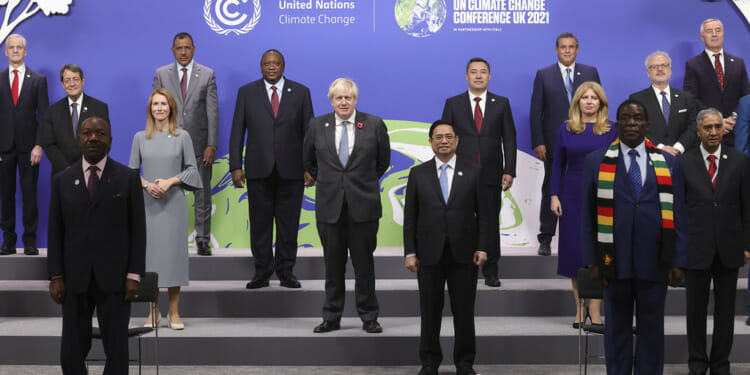A deal has been made at the COP26 climate conference but only just. Negotiations have seen countries agree to keep within reach the goal of limiting global heating to 1.5C, the key threshold of safety set out in the 2015 Paris agreement.
Discussions went on into Saturday night as nations tried to agree on what measures need to be put in place regarding phasing out coal, cutting greenhouse gas emissions and providing money to the poor world in order to meet their goal.
“The Glasgow Climate Pact” as it has been dubbed is a watered down version of what many nations hoped to produce. This is down to an intervention from India requesting a change in the language from “phasing out” coal to just “phasing down”. Energy experts were very clear that phasing out coal is necessary to stay within 1.5C of global warming but with this request, India has diluted this and opened the way for a global slowdown in phasing out coal.
BREAKING: The #COP26 Glasgow Climate Pact has been agreed.
It has kept 1.5 degrees alive.
But, it will only survive if promises are kept and commitments translate into rapid action.#TogetherForOurPlanet pic.twitter.com/PtplIsVPCF
— COP26 (@COP26) November 13, 2021
As one of the world’s leading coal users, along with China and South Africa, India felt it was not an essential step despite the science put to them. Thus the language in the agreement outlines a “phasing down of inefficient fossil fuel subsidies”.
Is phasing down going to be enough? Simply put, no. Coal is considered the dirtiest fossil fuel but it is also the cheapest which is what makes it so popular in the emerging world.
The use of coal must end globally in order to avoid a 2C rise in temperature at which point there is no return for our planet. Fatih Birol, executive director of the International Energy Agency, told the Guardian that over 40% of the existing 8,500 coal plants globally would have to close by 2030 and that there could be no creation of new plants if we hope to remain within the limit. As he put it, turning his attention to the leading nations:
“I would very much hope that advanced economies take a leading role and become an example for the emerging world. If they don’t do it, if they don’t show an example for the emerging world, they shouldn’t expect the emerging world to do it.”
The harsh reality is that India making this request could lead to irreversible global damage. India itself is already suffering from this policy decision: The effects of using primarily coal are starting to be highly visible in the country, with, for example, New Delhi engulfed in coal-induced smog, a phenomenon that comes back every year at this time.
On Saturday, as India fought for coal to be “phased down” instead of “phased out” New Delhi’s chief minister Arvind Kejriwal,was making the announcement that schools must close for a week due to high levels of air pollution. He said the decision to shut down schools starting Monday was made so that “children don’t have to breathe polluted air.”
It is also reported that Kejriwal has called for construction sites to be closed for four days and has stated that government officials will work from home encouraging private businesses to do the same in an attempt to reduce vehicle emissions.
Related Articles: COP26: Was Coal Really Consigned to History Yesterday? | Greta Thunberg calls COP26 a “failure” and a “PR event”
So we have the remarkable spectacle of New Delhi, India’s capital and the sub-continent’s megacity, considering a lockdown due to the heavy blanket of smog currently engulfing it, while India’s leaders are fighting for this not to change.
Delhi’s problem is nothing new. It struggles with high levels of pollution due to traditional crop stubble burning, high levels of vehicle emissions and of course, coal-fired power plants. The air in Delhi carries a high concentration of fine particles with a diameter of less than 2.5 micrometers – and hence very dangerous for human health – and it is reported to have exceeded 300 micrograms per cubic meter of air last Saturday, which is 20 times the World Health Organization’s recommended daily maximum.
India’s toxic air is proving fatal, as 1.67million people died in India due to the toxic air in 2019. This shows an alarming trend as that figure represents nearly one in five deaths in India that year. In 2017 there were 1.24million deaths related to air pollution – this suggests that unfortunately the problem is worsening year on year.
New Delhi is land-locked and it is the most polluted capital in the world. It is hard to fathom the reality that on the day Delhi’s chief minister was closing the city due to pollution the leaders of the country were fighting for a way to keep contributing to it. Yet they say they are committed to “phasing down” their emissions as Indian Prime Minister Narendra Modi pledged at COP26 for the first time that India would become carbon neutral by 2070.
But is it enough? With millions already dying from air pollution in India can they reach their goal by 2070? Can they reach their goal at all? They have 50 years to clear the smog but will the haze ever truly be lifted? We will have to wait to find out.
Meanwhile, India sets a poor example for the rest of the world and it is likely that more than one emerging economy will be tempted to continue with coal rather than transit to alternative, green energy sources.
The question is: What will it be like when nations meet next year at COP27 with their new climate plans – the strengthened NDCs they have been asked to produce?
Editor’s Note: The opinions expressed here by Impakter.com columnists are their own, not those of Impakter.com. — In the Featured Photo: COP26 World Leaders Summit Day 2. Featured Photo Credit: Number 10










